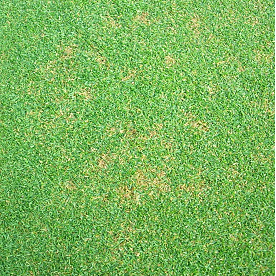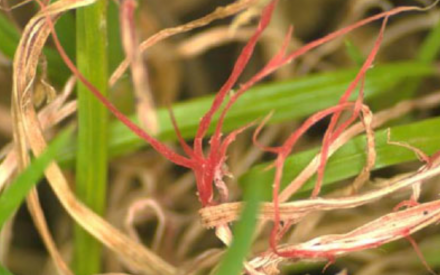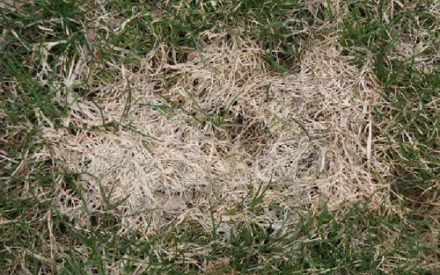What are Helminthosporium turf diseases?

Helminthosporium diseases of turf are a group of common, cool season turfgrass diseases (including Helminthosporium leaf spot and melting out) that occur throughout North America. In residential settings, these diseases can severely reduce the aesthetic appeal of a lawn and can lead to expensive lawn replacements.
What do Helminthosporium turf diseases look like?
Symptoms of Helminthosporium turf diseases vary, depending upon the specific pathogen, grass species, weather conditions, and cultural conditions involved. In general, the diseases lead to patches of thin, dead grass. On Kentucky bluegrass, and fine and tall fescues, initial symptoms are small, dark purple to black spots on the leaf blades. Older leaf spots on these hosts are often described as “eyespots” (i.e., round to oval spots with buff-colored centers surrounded by dark brown to dark purple margins). Infected bentgrasses often initially have a smoky-blue, water-soaked and matted appearance. As the disease progresses, infected leaves yellow and eventually die.
Where do Helminthosporium turf diseases come from?
Helminthosporium turf diseases are caused by several fungi, all of which were at one time lumped within the fungal genus Helminthosporium. More recently, these fungi have been reclassified into the genera Bipolaris, Drechslera, and Exserohilum. These fungi overwinter in infected turfgrass and turfgrass debris (e.g., thatch, grass clippings), and throughout the growing season, they produce spores that can readily infect leaf blades that have been wet for several hours. Disease development is favored during periods of high temperature when dry conditions alternate with prolonged stretches of cloudy, moist weather.
How do I save turf with Helminthosporium turf diseases?
Fungicides containing azoxystrobin, captan, chlorothalonil, fludioxonil, fluoxastrobin, iprodione, maneb, mancozeb, myclobutanil, PCNB, polyoxin D, propiconazole, pyraclostrobin, thiophanate-methyl, trifloxystrobin, thiram and vinclozolin are labeled for control of Helminthosporium turf diseases. These fungicides will not cure existing infections, but if they are applied early in disease development, may help prevent substantial losses. If you decide to use fungicides for control, be sure to read and follow all label instructions of the fungicide that you select to ensure that you use the fungicide in the safest and most effective manner possible.

How do I avoid problems with Helminthosporium turf diseases in the future?
Water, fertilize and mow your lawn properly to keep it healthy, and growing vigorously. See Lawn Maintenance for details. Turf requires approximately one inch of water per week from natural rain, supplemental irrigation or a combination of both. If you must irrigate, make sure to water deeply, but infrequently, to avoid drought. Avoid late afternoon and evening watering that can promote longer periods of moisture on leaves. DO NOT overfertilize. In particular, avoid heavy applications of nitrogen (especially fast-releasing forms of nitrogen such as urea), particularly during wet weather. Test leaf tissue from your turf routinely to make sure that the nitrogen to potassium ratio (N:K) is approximately 1:2, and fertilize appropriately to maintain this ratio. Keep your lawn mowed to between 2½ and 3½ inches, and never remove more than ⅓ of the existing growth when mowing. Keep the blade on your mower sharp. Ragged cuts, caused by dull mower blades, provide easier entry points for Helminthosporium turf disease fungi. Collect and destroy (by composting, burying or burning) lawn clippings from infected plants and try to clean any contaminated clippings from your mower. Helminthosporium turf disease fungi can survive and can easily be moved from place to place in grass clippings. If Helminthosporium turf diseases have been a problem in your lawn, consider using a blend of resistant turfgrass cultivars or a mixture of cool-season turfgrasses when establishing a new lawn or over-seeding an existing lawn. Resistant cultivars of Kentucky bluegrass include ‘Alpine’, ‘America’, ‘Boutique’, ‘Brilliant’, ‘Buckingham’, ‘Freedom II’, ‘Merion’, ‘Moonlight’, ‘Serene’, and ‘Unique’. See Turf Diseases of the Great Lakes Region for details.
In summary, to avoid problems with Helminthosporium turf diseases:
- Reduce leaf wetness (June to Sept.)
- Avoid drought stress (July, Aug.)
- Avoid excess N (May to Aug)
- Balance fertility (N:K = 1:2) (Spring, Fall)
- Mow at 2½ to 3½ in. (May to Nov.)
- Keep mower blades sharp (May to Nov.)
- Avoid mowing wet grass (May to Nov.)
- Collect diseased clippings (Spring)
- Plant resistant turf cultivars (Fall)
- Follow fungicide label (Always)
For more information on Helminthosporium turf diseases:
Contact the University of Wisconsin Turf Diagnostic Lab (TDL) at (608) 845-2535 or hockemeyer@wisc.edu.
Authors: Hye Sook Kim* and Brian Hudelson, UW-Plant Pathology Geunhwa Jung, University of Massachusetts Amherst-Plant, Soil and Insect Sciences
Last Revised: 03/01/2024
D-number: D0059
*Completed as partial fulfillment of the requirements for the graduate course: “Plant Pathology 559: Diseases of Economic Crops.”
References to pesticide products in this publication are for your convenience and are not an endorsement or criticism of one product over similar products. You are responsible for using pesticides according to the manufacturer’s current label directions. Follow directions exactly to protect the environment and people from pesticide exposure. Failure to do so violates the law.
Thanks to Diana Alfuth, Judy Reith-Rozelle and Deb Simons for reviewing this document.
A complete inventory of UW Plant Disease Facts is available at the University of Wisconsin-Madison Plant Disease Diagnostics Clinic website: https://pddc.wisc.edu.
Send a Plant Sample for Analysis
Be cautious when self-diagnosing plant health issues. Very few diseases can accurately be diagnosed by eye.
Contact the UW Plant Disease Diagnostics Clinic (PDDC), and for a small fee, clinic staff can examine a plant, determine the cause of the disease/disorder, and provide advice on how to control or prevent the issue.
Download Article





 Red Thread
Red Thread Moss in Lawn
Moss in Lawn Helminthosporium Turf Diseases
Helminthosporium Turf Diseases Lawn Disease Quick Reference
Lawn Disease Quick Reference


